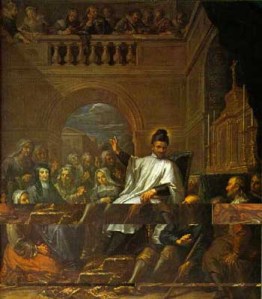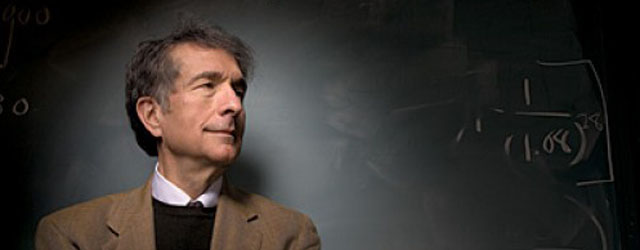Vincent and Howard Gardner:
Leading with Your Multiple Intelligences
Vincent de Paul, living as he did in 17th-Century France, most likely would not have considered the idea of humans having “multiple intelligences.” Dr. Howard Gardner, a professor of education at Harvard University, did not coin that term until 1983. However, we think it both important and inspiring to explore just how many of Gardner’s intelligences Vincent seemed to utilize as he accomplished his many works of charity.
In his groundbreaking book, Frames of Mind: The Theory of Multiple Intelligences, Gardner took on the traditional understanding of intelligence as a singular characteristic measured through the familiar I.Q. testing, which rates one’s ability to work with words and numbers. Instead, Gardner proposed seven different human intelligences.
In this post, we consider Gardner’s ideas on which intelligences are helpful for today’s leaders, and just how many of Gardner’s intelligences Vincent seemed to have as strengths.
Intelligence defined
To support his theory of multiple intelligences, Gardner defines intelligence as “a biopsychological potential to process information that can be activated in a cultural setting to solve problems or to create products that are of value in a culture” (1999. 33-34). An important point in this definition is that intelligence resides in us as a “potential.” For Gardner, each type of intelligence may or may not activate, depending on opportunities available in the culture and environment while we develop.
Gardner’s observation that the development of intelligence is dependent on cultural and environmental factors, means that each of us may differ quite markedly in the types of intelligence in which we excel. That difference has an impact on which way we most readily learn something new. This latter point has profound implications for education, which is one of the arenas in which Gardner’s work immediately had an influence.
Gardner’s idea of intelligence “potential” also means that if we presently score well in one or more intelligences, but come out less strong in others, we may be able to strengthen our weaker intelligences by creating opportunities to practice that form of intelligence.
Gardner also notes that definitions previous to his theory focused only on the ability to solve problems. They completely ignored the capacity to create (33). Essentially, that is why the label “smart” previously was applied only to people who were good at word problems or mathematical puzzles, and not to athletes, musicians, dancers, designers, entrepreneurs, and a host of other people who are good at what they do, only in different ways. To take all of these people into account, Gardner identified seven different forms of intelligence:
- Linguistic intelligence (sensitivity to spoken and written language, ideas)
- Logical-mathematical intelligence (numbers, logic, reasoning)
- Spatial intelligence (images, spatial perception, meanings)
- Bodily-Kinesthetic intelligence (physical agility, body movement control)
- Musical intelligence (awareness of sound, rhythm, patterns)
- Interpersonal intelligence (understanding of people, their feelings, relationships)
- Intrapersonal intelligence (understanding of self, own needs, capacities)
Intelligence and Leadership
Which of these seven intelligences is helpful in leadership? Gardner identifies several, and offers this summary of the ones he says are “crucial” for today’s leaders:
First, they are gifted with language; they can tell effective stories and often can write skillfully, too. Second, they display strong interpersonal skills; they understand the aspirations and fears of other persons, whom they can influence. Third, they have a good intrapersonal sense – a keen awareness of their own strengths, weaknesses, and goals – and they are prepared to reflect regularly on their personal course. Finally, the most effective leaders are able to address existential questions: They help audiences understand their own life situations, clarify their goals, and feel engaged in a meaningful quest (1983, 128).
There are several ways in which Gardner’s theory might be helpful to one’s own leadership development. These include:
1. Assessments based on Gardner’s theory offer language and a framework for becoming more familiar with one’s own “smart” areas of intelligence;
2. Using assessments to identify different approaches to learning for the members of a team can help improve overall effectiveness;
3. Knowing about the different types of intelligence can help leaders design presentations that will appeal to different intelligences in others;
4. Identifying one’s own “smart” intelligences can guide leaders in finding colleagues who can help compensate for weaker intelligences in completing a task.
Vincent’s Multiple Intelligences
Recalling a few stories from his life helps us to speculate about Vincent de Paul in relationship to Gardner’s theories. For example, it would appear that Vincent’s potential for linguistic intelligence was highly developed. Gardner says people with a high linguistic intelligence include lawyers, speakers, writers and poets. Historians say Vincent obtained a law degree as a young man, and wrote more than 30,000 letters during his lifetime. The letters still in existence are quite interesting and well-crafted.
Vincent also preached and taught regularly, and wrote several “rules” by which his first followers served the poor.
Vincent’s logical-mathematical intelligence also appears well-developed. People with this intelligence often make good business people and politicians. Vincent evidences this intelligence in his ability to maintain the finances for the ministries he helped to organize. He also managed a carriage company given to him by the king to help finance his charitable works.
Gardner’s description of spatial-visual intelligence suggests that features of this potential include the ability to manipulate the patterns of both wide and more confined areas as, for example, architects do. This ability also can lend itself to seeing and articulating patterns in a way one might call visionary. Vincent proved over and over again that he was able to see situations of need around him and propose solutions that others had not seen.
The two personal intelligences identified by Gardner allow one to successfully navigate one’s own life, and work effectively with others. Vincent’s interpersonal intelligence comes through clearly in his letters, in which he often offers advice to his confreres on matters of their own or others’ concern. Vincent’s self-awareness also often comes through in his letters and teachings. Two lines from a letter written by Vincent to Louise de Marillac show his ability to be forthcoming about his own state of mind, as well as sensitive to her need for his advice: “I am writing to you at about midnight and am a little tired. Forgive my heart if it is not a little more expansive in this letter” (October 1627. Coste.15)![]()
Apparently, even without an awareness of Howard Gardner’s theory, Vincent de Paul was indeed someone who worked to develop several of his human intelligences in order to be effective in his efforts to serve the poor and inspire his collaborators in that work.
Reflection Questions
What was most helpful to you in learning about Gardner’s theory of multiple intelligences?
How might you apply this theory and the examples from Vincent’s life to your own leadership development?
How might understanding Gardner’s theory help you to empower the growth of other Vincentian leaders?
Resources
Gardner, Howard. Frames of Mind: The Theory of Multiple Intelligences, Basic Books (www.perseusbooks.com). 1983. 128. Used with permission.
Gardner, Howard. Intelligence Reframed, Basic Books (www.perseus books.com). 1999. 33-34. Used with permission.
http://www.businessballs.com/howardgardnermultipleintelligences.htm (includes access to free assessments)
http://thomasarmstrong.com/multiple_intelligences.php
Edited by Patricia M. Bombard, BVM, D.Min., Director, Vincent on Leadership: The Hay Project, DePaul University, Chicago, IL USA



